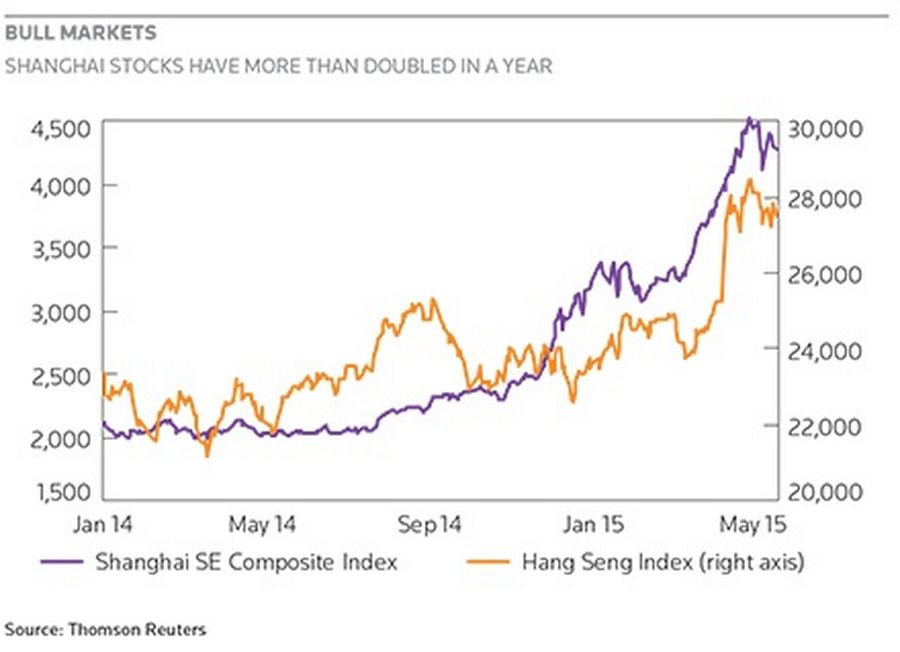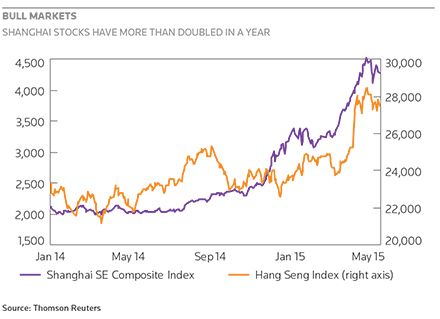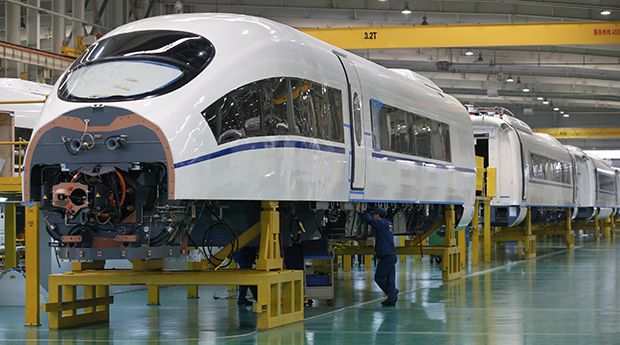A landmark trading link between Shanghai and Hong Kong has taken longer than expected to build momentum, but rising trading volumes are enhancing its significance as a template for China’s liberalisation.
Now that the highly anticipated Greater China cross-border link has started to gain traction, market participants around the globe are angling to step in and encourage authorities to incorporate into the platform other bourses, such as that in Shenzhen, as well as more asset classes like bonds.
Trying to make Shanghai-Hong Kong Stock Connect work for multiple markets and classes of investors will pose many challenges for regulators. Nonetheless, the scheme has proved to be a solid initial step so far towards the opening up capital markets in the world’s second-biggest economy to outside investors. Foreign and local investors eagerly await changes to make the platform more inclusive.
The Stock Connect platform was launched last November with much fanfare. After months of disappointing trading volumes, the pilot programme finally took off as regulators made amendments and investors became more comfortable with the terms.
Escalating trading volume spurred administrators and others to start to sketch plans to include exchanges in Shenzhen and Taipei in the platform. Yet, while these plans remain in the early stages, the biggest achievement for the trading link’s administrators has been to draw unprecedented attention to the Chinese capital markets.
“I think Stock Connect, in terms of overall volume, hasn’t been the massive success that a lot of people were expecting to see, but, overall, it has been fantastic progress in order to open the door to the onshore Chinese capital markets,” said Julien Martin, head of BNP Paribas’ RMB Competence Centre.

Bull markets
Foreign investors had been curious about Chinese equity markets long before Stock Connect launched on November 17. Mainland markets were already performing well on the back of regulatory changes and the increased use of margin financing to buy stocks. In fact, at the time of launch, benchmark indices on Shanghai and Shenzhen were already up 17% and 25% on the year, respectively.
However, the new trading link, coupled with mainland interest rate cuts, helped push the indices much higher, market participants said. Shanghai and Shenzhen indexes are up about 73% and 90%, respectively, since regulators launched the initiative last November – a factor that has only further heightened foreigners’ desire for mainland stocks.
Southbound trading volume from Shanghai-based funds into Hong Kong has not been as heavy, even though the Hang Seng Index has climbed about 15% since the platform was launched (versus a mere 1.3% increase all of 2014).
“This concept of the scheme is scalable. It may not be technically scalable if you want to incorporate other asset classes, like bonds, but it’s scalable for equities, and other exchanges inside and outside of China are looking to participate.”
Still, market participants say investments into Hong Kong and beyond through the platform will eventually grow as onshore money managers become more sophisticated and mainland regulators keep encouraging them to put more capital into other markets.
“What’s important is that it is the first real two-way scheme,” said BNP’s Martin. “Regulators have realised that it’s not just about money going into China; it’s also about money moving out of China. Even though there has been only one day so far when the daily limit for southbound flow has been hit, it’s still important: mainland investors have more options.”
Mainland investors used their full Rmb10.5bn daily quota for the first and only time on April 8.
No major mishaps
For many, however, the overall usage of the platform is not as important as the fact that there have been no major mishaps since launch. Trade errors or glitches in technology would have scared away investors far more than lower-than-expected volumes, sources said.
That is partly why regulators are interested in expanding the platform at such an early stage.
Many exchanges have been mooted as possibly additions to the existing Shanghai-Hong Kong network and these include Shenzhen, New York, London, Singapore, and Taipei. A connection to Shenzhen, at this point, is the most likely next step and, if that is a success, regulators may look to incorporate other exchanges.
“This concept of the scheme is scalable,” Martin said. “It may not be technically scalable if you want to incorporate other asset classes, like bonds, but it’s scalable for equities, and other exchanges inside and outside of China are looking to participate.”
Including more shares in the programme with the addition of more bourses should also help the A shares take the next crucial step to becoming global: they could become part of benchmark indices like the MSCI. Once A shares are included, international investment funds will have to match the index weighting, funnelling hundreds of billions of dollars into the mainland market.
Last June, the MSCI decided not to include mainland shares in its benchmark emerging-markets index because it found the A-share market too restrictive for foreigners. The index provider will revisit A-share inclusion next month and has said Stock Connect will factor into its decision.
All of this bodes well for global investment banks, too. Their equities platforms have been looking for new regions in which to trade as margins in developed markets in the US and Europe have become razor thin. Chinese markets could provide these firms with what they are looking for.
“In most equity business lines, we see margin compression,” said Rob Ebert, head of equities for Asia Pacific at Deutsche Bank. “Even in APAC legacy business, there is margin compression, but we now have the opportunity to open one of the most liquid capital markets in the world in China. This will add a new revenue stream and increase margins.”
At the same time, market participants are already putting together plans to move the platform beyond equities and into bonds, an initiative that sources say will be more complex than the original Stock Connect.
At present, Asia Securities Industry and Financial Markets Association, or Asifma, is working on plans for a bond-trading platform to circulate among regulators and other market participants.
One of the plans under consideration calls for regulators to expand Stock Connect to include the bonds traded on the Shanghai Stock Exchange to create a global bond trading platform in Hong Kong to encourage two-way flows. However, as only a small fraction of China’s bond market, the world’s third largest, trades on that bourse, it will be a very limited platform.
Another option is to base a “Bond Connect” on the existing qualified foreign institutional investor (QFII) schemes, but with one overall quota monitored by one central authority, as in the Stock Connect model. QFII gives quotas to individual institutions.
Capital markets impact
Meanwhile, corporate finance bankers welcome changes to these cross-border initiatives that will allow companies to price share offerings on one exchange using capital flows from another. So far, Stock Connect’s administrators have focused on secondary markets, although there are expectations that primary issuance will be soon be part of the programme.
“The connect mechanism in and of itself doesn’t have a direct impact on equity capital markets issuance at present,” said Damien Brosnan, head of Asia ex-Japan equity syndicate at UBS. “ At the moment, domestic investors cannot use it for IPOs or placements. There is a mechanism for rights participation, but it is still untested.”
Yet, the increases in turnovers in Hong Kong and Shanghai have brought about material changes to stocks listed in the cities.
“With some of the smaller-cap names listed in Hong Kong, we’ve seen material changes in shareholder composition, in their liquidity profiles and share prices,” Brosnan said.
Investors are targeting small-cap stocks in anticipation of regulators inviting the largely small-cap Shenzhen bourse to be part of the programme.
“That creates a very different technical dynamic to execute ECM transactions in those stocks that couldn’t be done prior to the current rally, such as secondary block trades and primary equity capital raises,” he said.
Nonetheless, all the opportunities that Stock Connect has directly or indirectly created are still relatively small. Regulators have a lot of work to do if they want to open up the Chinese capital markets completely to foreigners.
“The size of onshore equity market in Shanghai is about Rmb34trn and a Rmb300bn northbound quota is still a drop in the ocean,” BNP’s Martin said. “There is a lot of interest offshore and it will grow as Chinese authorities talk about making their markets more liberal and efficient. In order to do that, they have to open the door to foreigners in order to transform China’s market into a globally accessible market.”
To see the digital version of this report, please click here
To purchase printed copies or a PDF of this report, please email gloria.balbastro@thomsonreuters.com

